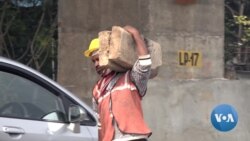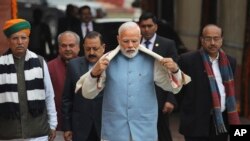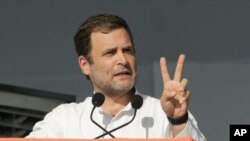For people streaming in from rural areas around New Delhi, the first stop is a collection of busy city intersections where contractors select daily wage labor from the crowds of young and old waiting every morning to get work.
Many standing at these intersections say they get work for barely half the month. “I have the ability to work hard. I never turn down any work. But I would prefer to get a cleaner, permanent job,” says 29-year-old Tek Chand. "The problem is one day I have money to buy rations, the next day I don’t." Like millions of others, he migrated from his village three years ago to seek work and a better life in the city.
As India prepares for general elections on April 11, Prime Minister Narendra Modi is being attacked by opposition parties for failing to make good on a promise he made in 2014 to create millions of jobs for India’s huge young population. Modi’s Bharatiya Janata Party rebuts that criticism and says India is generating new opportunities as it becomes one of the world’s fastest growing major economies.
Job creation is a massive challenge for a nation with one of the world’s youngest populations -- half the country’s 1.3 billion people are under the age of 25.
Recent data shows that joblessness has soared to record high levels. Opposition parties have made joblessness one of their principal election planks and have accused the prime minister of failing the estimated 8 to 10 million young people who enter the workforce every year.
The independent Mumbai-based Center for Monitoring Indian Economy estimates that unemployment reached 7.2 percent last month and that 11 million jobs were lost in 2018. With a working population of 500 million, that translates into more than 30 million people waiting for jobs. An unpublished official survey that showed unemployment at a 45-year-high has also been widely quoted by Indian media.
On the campaign trail, the head of the main opposition Congress Party, Rahul Gandhi, who is seen as Modi’s principal challenger, talks repeatedly about a “jobs crisis.”
“Our government is refusing to accept that we have a massive crisis and potential disaster in front of us,” Gandhi told a group of university students in New Delhi recently, many who will be first time voters.
Modi’s Bharatiya Janata Party dismisses concerns about the job data saying it does not capture the real picture because it focuses only on the 15 percent of Indians who work in the formal economy. It points to a recent industry report that jobs have been created in the medium and small sectors.
The BJP says millions of people have found work in the transport and infrastructure sectors or as delivery boys in booming online businesses as India becomes one of the world’s fastest growing major economies. They point out that the issue is not jobs but livelihoods, and point to millions of people who are not counted in job data.
They are self-employed people like cab owner Chain Pal Singh. As the app based taxi business boomed, Singh’s friend, who operated a cab, persuaded him to quit his job and take out a loan to buy a car. His decision has paid off -- in four years he has earned enough money to invest in two more cabs.
Singh says he is much better off than when he held a job. “I used to earn about $225 dollars a month. Now in some months I can earn almost double that amount. Its beneficial for me.”
Following defeats in key state elections in December, Prime Minister Narendra Modi told parliament last month, “This truth has to be acknowledged. The unorganized sector has 80 to 85 percent of the employment.” He pointed to millions of commercial vehicles sold in recent years and questioned if they had not generated jobs for drivers.
Economists admit India’s large informal sector has made it difficult to calculate employment, but they say joblessness or underemployment remains the country’s biggest challenge. While scarcity of jobs is not a new problem, two disruptive economic steps in the last two years exacerbated the problem.
In 2016 a sweeping currency ban meant to tackle the problem of illegal cash, dried up jobs as it created huge currency shortages, particularly in small businesses and in the countryside. A poorly-implemented tax reform known as the Goods and Services Tax a few months later was another blow to businesses.
Meanwhile, Modi’s “Made in India” campaign, which aimed at making India a manufacturing hub like China, has made a slow start and sluggish labor-intensive sectors cannot cater to growing numbers of job seekers.
“We can't keep patting ourselves on the back that we are the fastest growing economy specially if all these other indicators are not growing at a rate that will absorb the growing labor force,” says Santosh Mehrotra, a human development economist at the Jawaharlal Nehru University in New Delhi.
“More young people are entering the labor force, millions want to leave agriculture but can’t find construction work because construction activity has slowed down because the investment rate in the economy has slowed down.”
He points out that exports, another sector that created a number of jobs has also not been performing well.
As the campaign heats up, the opposition will try to keep the spotlight on jobs, or lack of them, even as the BJP tries to focus on national security following a recent confrontation with Pakistan. The final verdict on whether to give Prime Minister Modi a second term in office will be delivered by millions of voters when they cast their ballots.








